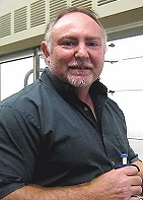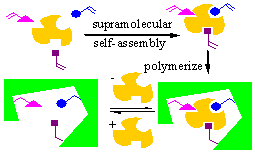David Spivak

Professor - Organic, Polymer, and Bioanalytical Materials Chemistry
Bachelor's Degree(s): University of California-Berkeley, 1989
PhD: University of California, Irvine, 1995
PostDoc: The Scripps Research Institute, 1995-98
Website: Spivak Research Group
Area of Interest
Broadly defined, research in our group involves the development of synthetic methodology, with particular applications to template-organized polymer materials. Potential applications are in the areas of chromatography, catalysis, bioÂmedical materials, molecular recognition and sensor technology. Two major areas of interest in our group are illustrated below.
Molecular Imprinting in 3-D Network Polymers: Network polymers can also be engineered for molecular recognition and catalytic properties using the method of molecular imprinting, shown below. To imprint a molecule, functionalized monomers are bound to a template molecule and the resulting complex is copolymerized with cross-linking monomers. Removal of the template leaves cavities in the polymer that are complementary in size, shape and chemical functionality to the template molecule. This rapidly developing technique provides polymeric artificial receptors, catalysts, organic zeolites, chromatographic supports and biosensors.

Molecular Imprinting in 2-D films: In order to obtain surface-imprinted and/or thin film materials, we are exploring an alternative strategy that involves molecular imprinting of alkanethiol self-assembled monolayer films (i.e. SAMs) on gold. The general strategy is illustrated below, for color-changing thin film for sensor applications. The third and/or fourth involve removal of the template, followed by the fifth step which is to verify and quantify binding and selectivity of the template by the imprinted film. Other variations on this theme are also being explored.

Awards & Honors
Associate Editor, Journal of Molecular Recognition; 2006-present
National Academy of Sciences - Alexander Von Humboldt Foundation: 9th Annual German-American Frontiers of Science, Invited Speaker; 2003
NSF CAREER Award, 2002
Research Corporation Cottrell Scholar Award, 2001
Louisiana State University Tiger Athletic Foundation Undergraduate Teaching Award, 2001
Oak Ridge Associated Universities, Ralph E. Powe Junior Faculty Enhancement Award, 2000
Ralph E. Powe Junior Faculty Enhancement Award, 2000
NIH Post-Doctoral Fellowship, 1995-1997
Selected Publications
1. Bai, Wei; Spivak, David A. "A
Double-Imprinted Diffraction-Grating Sensor Based on a Virus-Responsive Super-Aptamer
Hydrogel Derived from an Impure Extract" Angewandte Chemie International Edition,
2014, 53, 2095-2098.
2. Krupadam, R. J.; Nesterov, E. E.;
Spivak, D. A., Highly selective detection of oil spill polycyclic aromatic hydrocarbons
using molecularly imprinted polymers for marine ecosystems. J. Hazard. Mater. 2014,
274, 1-7
3. Berton, P.; Regmi, B. P.; Spivak, D.
A.; Warner, I. M., Ionic liquid-based dispersive microextraction of nitrotoluenes
in water samples. Microchimica Acta, 2014, 181, 1191-1198.
4. Meador, Danielle; Spivak, David A.
"Absolute Configuration Determination Using Enantiomeric Pairs of Molecularly Imprinted
Polymers" Organic Letters, 2014, 16, 1402-1405.
5. Bai, Wei; Gariano, Nicholas A.;
Spivak, David A. "Macromolecular Amplification of Binding Response in Superaptamer
Hydrogels"
Journal of the American Chemical Society 2013, 135, 6977-6984.
6. Balamurugan, Subramanian; Mayer,
Kathryn M.; Lee, Seunghyun; Soper, Steven A.; Hafner, Jason H.; Spivak, David A. "Nanostructure
shape effects on response of plasmonic aptamer sensors" Journal of Molecular Recognition,
2013, 26, 402-407.
7. Astete, Carlos E.; Songe Meador,
Danielle; Spivak, David; Sabliov, Cristina; "Synthesis of Vitamin E-Carnosine (Vecar):
New Antioxidant Molecule with Potential Application in Atherosclerosis" Synthetic
Communications, 2013, 43, 1299-1313. DOI:10.1080/00397911.2011.632829.
8. Spivak, David A. "Enantioseparations
by high-performance liquid chromatography using molecularly imprinted polymers" Methods
in Molecular Biology; Scriba, Gerhard K.; Ed.; Springer, New York, NY, USA; 2013,
970 (Chiral Separations), 209-220.
9. Horemans, F.; Weustenraed, A.; Spivak,
D.; Cleij, T. J., "Towards water compatible MIPs for semsing in aqueous media" Journal
of Molecular Recognition, 2012, 25, 344-351.
10. Spivak, David A.; Shea, Kenneth J.,
"Editorial: MI2010: The Future of Molecular Imprinting" Journal of Molecular Recognition
2012, 25, 319.
11. Tiwari, Rajesh; Spivak, David A.;
"Kinetics and mechanism of the charge-transfer polymerization of methyl methacrylate
initiated with n-butyl amine and carbon tetrachloride catalyzed by palladium dichloride"
Journal of Applied Polymer Science, 2012, 124, 4025-4032.